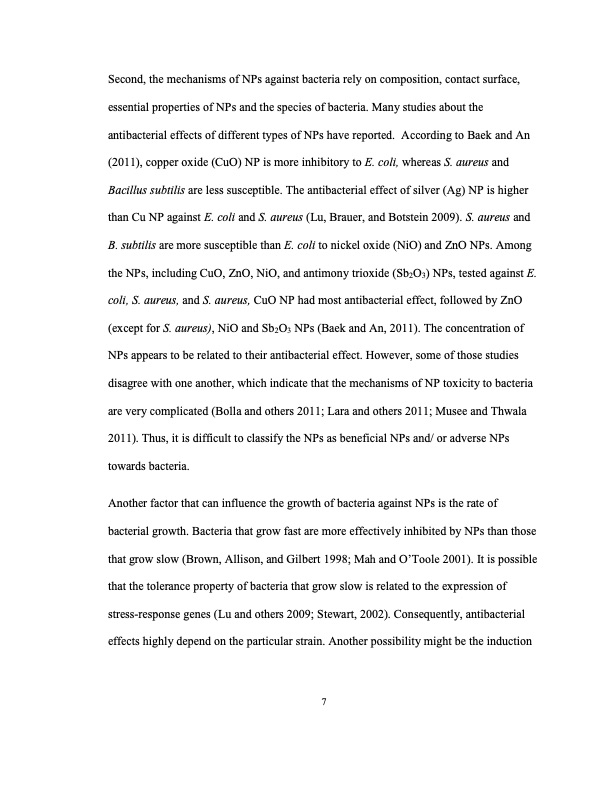
PDF Publication Title:
Text from PDF Page: 018
Second, the mechanisms of NPs against bacteria rely on composition, contact surface, essential properties of NPs and the species of bacteria. Many studies about the antibacterial effects of different types of NPs have reported. According to Baek and An (2011), copper oxide (CuO) NP is more inhibitory to E. coli, whereas S. aureus and Bacillus subtilis are less susceptible. The antibacterial effect of silver (Ag) NP is higher than Cu NP against E. coli and S. aureus (Lu, Brauer, and Botstein 2009). S. aureus and B. subtilis are more susceptible than E. coli to nickel oxide (NiO) and ZnO NPs. Among the NPs, including CuO, ZnO, NiO, and antimony trioxide (Sb2O3) NPs, tested against E. coli, S. aureus, and S. aureus, CuO NP had most antibacterial effect, followed by ZnO (except for S. aureus), NiO and Sb2O3 NPs (Baek and An, 2011). The concentration of NPs appears to be related to their antibacterial effect. However, some of those studies disagree with one another, which indicate that the mechanisms of NP toxicity to bacteria are very complicated (Bolla and others 2011; Lara and others 2011; Musee and Thwala 2011). Thus, it is difficult to classify the NPs as beneficial NPs and/ or adverse NPs towards bacteria. Another factor that can influence the growth of bacteria against NPs is the rate of bacterial growth. Bacteria that grow fast are more effectively inhibited by NPs than those that grow slow (Brown, Allison, and Gilbert 1998; Mah and O’Toole 2001). It is possible that the tolerance property of bacteria that grow slow is related to the expression of stress-response genes (Lu and others 2009; Stewart, 2002). Consequently, antibacterial effects highly depend on the particular strain. Another possibility might be the induction 7PDF Image | ZINC OXIDE AND SILVER NANOPARTICLES ON INTESTINAL BACTERIA

PDF Search Title:
ZINC OXIDE AND SILVER NANOPARTICLES ON INTESTINAL BACTERIAOriginal File Name Searched:
thesis-zinc-oxide-silver-nano.pdfDIY PDF Search: Google It | Yahoo | Bing
Turbine and System Plans CAD CAM: Special for this month, any plans are $10,000 for complete Cad/Cam blueprints. License is for one build. Try before you buy a production license. More Info
Waste Heat Power Technology: Organic Rankine Cycle uses waste heat to make electricity, shaft horsepower and cooling. More Info
All Turbine and System Products: Infinity Turbine ORD systems, turbine generator sets, build plans and more to use your waste heat from 30C to 100C. More Info
CO2 Phase Change Demonstrator: CO2 goes supercritical at 30 C. This is a experimental platform which you can use to demonstrate phase change with low heat. Includes integration area for small CO2 turbine, static generator, and more. This can also be used for a GTL Gas to Liquids experimental platform. More Info
Introducing the Infinity Turbine Products Infinity Turbine develops and builds systems for making power from waste heat. It also is working on innovative strategies for storing, making, and deploying energy. More Info
Need Strategy? Use our Consulting and analyst services Infinity Turbine LLC is pleased to announce its consulting and analyst services. We have worked in the renewable energy industry as a researcher, developing sales and markets, along with may inventions and innovations. More Info
Made in USA with Global Energy Millennial Web Engine These pages were made with the Global Energy Web PDF Engine using Filemaker (Claris) software.
Infinity Turbine Developing Spinning Disc Reactor SDR or Spinning Disc Reactors reduce processing time for liquid production of Silver Nanoparticles.
| CONTACT TEL: 608-238-6001 Email: greg@infinityturbine.com | RSS | AMP |